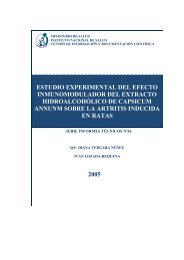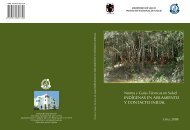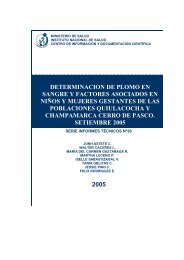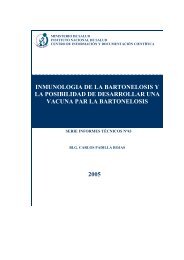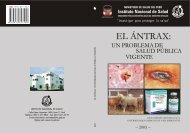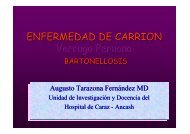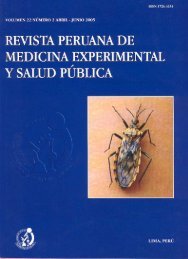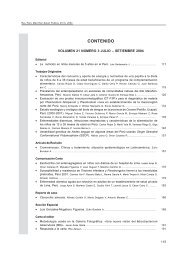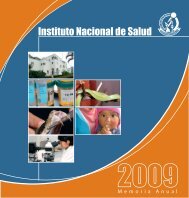Rev peru med exp salud publica 20 (4), 2003COMPARACIÓN DE LA EDUCACIÓN POR PARES Y PORPROFESIONALES DE LA SALUD PARA MEJORAR EL CONOCIMIENTO,PERCEPCIÓN Y LA CONDUCTA SEXUAL DE RIESGO ENADOLESCENTESSixto Sánchez C 1 , Guillermo Atencio L 2 . Naguye Duy 3 , Mirtha Gran<strong>de</strong> B 4 , Maria Flores O 2 , Marina Chiappe G 5 ,Raúl Nalvarte T 6 , Jorge Sánchez F 7 , King K Holmes 8 .RESUMENObjetivo: Comparar la educación por pares frente a la educación por profesionales <strong>de</strong> a consultorios <strong>de</strong> planificaciónfamiliar <strong>de</strong> dos hospitales <strong>de</strong> Lima, Perú. Material y Métodos: Estudio experimental simple ciego realizado en 1998 en losconsultorios <strong>de</strong> planificación familiar <strong>de</strong>l Hospital Dos <strong>de</strong> Mayo y el <strong>Instituto</strong> Materno Perinatal <strong>de</strong> Lima, Perú. Después <strong>de</strong>lconsentimiento, se asignó aleatoriamente a 206 adolescentes consi<strong>de</strong>radas <strong>de</strong> riesgo a una <strong>de</strong> las dos intervencioneseducativas y luego fueron invitadas a regresar al final <strong>de</strong>l tercer mes para reevaluar sus conocimientos, actitu<strong>de</strong>s y conductasexual <strong>de</strong> riesgo. Se usó la prueba <strong>de</strong> los signos, Mann Whitney y análisis <strong>de</strong> Covarianza para comparar los puntajes <strong>de</strong>los cuestionarios <strong>de</strong> conocimiento, percepción <strong>de</strong> riesgo y conducta sexual <strong>de</strong> riesgo <strong>de</strong>spués <strong>de</strong> la intervención educativa.Resultados: 89 (84%) <strong>de</strong> 106 adolescentes asignadas al grupo <strong>de</strong> educación por pares y 70 (70%) <strong>de</strong> las 100 asignadasal grupo <strong>de</strong> educación por profesionales <strong>de</strong> la salud (p=0,02) regresaron a la evaluación postintervención. El mejoramiento<strong>de</strong>l nivel <strong>de</strong> conocimiento fue significativamente mayor (p=0,047) en el grupo <strong>de</strong> educación por pares que en el grupocapacitado por profesionales <strong>de</strong> la salud; sin embargo, esta significancia disminuyó (p=0,07) cuando se usó análisis <strong>de</strong>covarianza para controlar el puntaje obtenido antes <strong>de</strong> la intervención. El mejoramiento <strong>de</strong> la percepción y conductas <strong>de</strong>riesgo fue mayor en el grupo <strong>de</strong> pares pero esta diferencia no fue significativa. Conclusiones: La educación por pares<strong>de</strong>mostró ser más efectiva en mejorar los conocimientos en las adolescentes y el seguimiento fue mejor en este grupo porlo que <strong>de</strong>be ser promovida como una estrategia para disminuir la prevalencia <strong>de</strong> infecciones <strong>de</strong> transmisión sexual en estapoblación.Palabras clave: Adolescentes; Educación; Grupos <strong>de</strong> Pares; Enfermeda<strong>de</strong>s Sexualmente Transmisibles; Servicios <strong>de</strong>Planificación Familiar. (fuente: BIREME).ABSTRACTObjective: To compare peer education versus that imparted by health professionals for improving knowledge, risk perceptionand risky sexual behavior among teenagers attending to family planning clinics of two hospitals in Lima. Material andMethods: Experimental single-blind study carried out at the family planning clinics of Hospital Dos <strong>de</strong> Mayo and <strong>Instituto</strong>Materno Perinatal during the year 2000. After signing an informed consent, 206 teenagers consi<strong>de</strong>red as being at risk wererandomly assigned to one of the two educational interventions and later they were requested to come back at the end ofthe third month in or<strong>de</strong>r to reassess knowledge, attitu<strong>de</strong>s and risky sexual behavior. Sign rank, Mann Whitney and Analysisof Covariance tests were used to compare scores for knowledge, risk perception and sexual behavior after the educationalintervention. Results: 89 (84%) out of 106 teenagers assigned to the peer education and 70 (70%) out of 100 teenagersassigned to the education provi<strong>de</strong>d by health professionals (p= 0,02). Improvement in the level of knowledge was significantlyhigher (p= 0,047) in group with peer education compared to the group trained by health professionals; however, significance<strong>de</strong>creased (p= 0,07) when analysis of covariance was used taking into account the scores for the first interview. Improvementsin risk perception and sexual behavior were higher in the group with peer education, but the difference was not statisticallysignificant. Conclusions: Peer education proved to be more effective in improving knowledge and the group un<strong>de</strong>rgoingthis approach had better follow up rates, so peer education should be promoted as a strategy for <strong>de</strong>creasing the prevalenceof sexually transmitted infections in this population.Key words: Teenagers; Education; Peer Groups; Sexually Transmitted Diseases; Family Planning Services. (source:BIREME).1Hospital <strong>Nacional</strong> Dos <strong>de</strong> Mayo, Lima, Perú.2<strong>Instituto</strong> Materno Perinatal, Lima, Perú.3Programa MIRT <strong>de</strong> la Universidad <strong>de</strong> Washington.4Asociación <strong>de</strong> Lucha contra el SIDA Vía Libre, Lima, Perú.5Universidad Peruana Cayetano Heredia, Lima, Perú.6Ministerio <strong>de</strong> <strong>Salud</strong> <strong>de</strong>l Perú.7Asociación Impacta <strong>Salud</strong> y Educación, Lima, Perú.8Universidad <strong>de</strong> Washington.Este estudio contó con el apoyo técnico y financiero <strong>de</strong>l Proyecto Vigía“Enfrentando las Amenazas Infecciosas Emergentes y Reemergentes”(MINSA/USAID), y <strong>de</strong>l Programa MIRT <strong>de</strong> la Universidad <strong>de</strong> Washington.INTRODUCCIÓNLa prevalencia <strong>de</strong> algunas infecciones <strong>de</strong> transmisiónsexual (ITS) en mujeres adolescentes es alta. En unestudio realizado por el Programa <strong>de</strong> Control <strong>de</strong>Enfermeda<strong>de</strong>s <strong>de</strong> Transmisión Sexual y SIDA <strong>de</strong>lMinisterio <strong>de</strong> <strong>Salud</strong> <strong>de</strong>l Perú en el año 2000 (datos nopublicados) se encontró que en mujeres menores <strong>de</strong> 20años, la prevalencia <strong>de</strong> infección cervical por Chlamydiatrachomatis en el Hospital Dos <strong>de</strong> Mayo fue <strong>de</strong> 25,7%mientras que en las mujeres mayores <strong>de</strong> 20 ó más años<strong>de</strong> edad fue 9,1%.206
Rev peru med exp salud publica 20 (4), 2003Educación por pares y por profesionales <strong>de</strong> la salud en adolescentesLas mujeres adolescentes constituyen el 22,8% 1 <strong>de</strong> lapoblación en el Perú y están en riesgo <strong>de</strong> adquiririnfecciones <strong>de</strong> transmisión sexual 2 y el VIH <strong>de</strong>bido a su<strong>de</strong>sventaja <strong>de</strong> género, la precocidad sexual cada vezmayor 3,1 , su ten<strong>de</strong>ncia a exponerse a riesgos, el bajo nivelsocioeconómico, la falta <strong>de</strong> conocimientos sobresexualidad, el escaso uso <strong>de</strong> condón 4 y el <strong>de</strong>sconocimiento<strong>de</strong> la actividad sexual <strong>de</strong> su pareja.En el Perú, el mayor número <strong>de</strong> casos notificados <strong>de</strong> SIDAesta entre los 20 y los 34 años y se asume que losinfectados entre 20 y 25 años se infectaron durante laadolescencia. 3,3% <strong>de</strong> pacientes con SIDA en el año 1997tuvieron entre 13 y 19 años 5 .Esto <strong>de</strong>muestra la necesidad <strong>de</strong> implementar activida<strong>de</strong>sefectivas <strong>de</strong> educación dirigidas a las adolescentes. Laestrategia <strong>de</strong> pares en adolescentes han evi<strong>de</strong>nciado ciertoéxito 6 . Los adolescentes, generalmente reciben lainformación acerca <strong>de</strong> sexualidad a partir <strong>de</strong> otros jóvenesy <strong>de</strong> los medios <strong>de</strong> comunicación. La influencia <strong>de</strong> otrosadolescentes es muy importante durante su proceso <strong>de</strong>maduración 3,7-10 a medida que se van in<strong>de</strong>pendizando <strong>de</strong>sus familias. De aquí nace la necesidad <strong>de</strong> evaluar laeducación recibida por las adolescentes a partir <strong>de</strong> otraspersonas como ellas.El objetivo principal <strong>de</strong> este estudio fue comparar laefectividad <strong>de</strong> la educación <strong>de</strong> pares con la educaciónbrindada por profesionales <strong>de</strong> salud en cuanto almejoramiento <strong>de</strong>l conocimiento, percepción y prácticas <strong>de</strong>riesgo en la población adolescente que acu<strong>de</strong> a losconsultorios <strong>de</strong> planificación familiar <strong>de</strong> estos dosestablecimientos <strong>de</strong> salud con alta prevalencia <strong>de</strong>enfermeda<strong>de</strong>s <strong>de</strong> transmisión sexual en este grupo etáreo.MATERIAL Y MÉTODOSEste estudio se llevó a cabo en el año 2000 en losconsultorios <strong>de</strong> planificación familiar <strong>de</strong>l Hospital Dos <strong>de</strong>Mayo y <strong>de</strong>l <strong>Instituto</strong> Materno Perinatal, Lima, Perú. Estudio<strong>de</strong> diseño experimental simple ciego.Se seleccionó a 10 adolescentes mujeres usuarias <strong>de</strong> losservicios <strong>de</strong> planificación familiar <strong>de</strong> ambosestablecimientos <strong>de</strong> salud las cuales fueron elegidas porsu capacidad <strong>de</strong> li<strong>de</strong>razgo, luego capacitadas por un total<strong>de</strong> 10 h en temas <strong>de</strong> planificación familiar, prevención <strong>de</strong>ITS/VIH-SIDA, género, autoestima, entre otros. Dos <strong>de</strong>estas 10 adolescentes (una por cada establecimiento)fueron seleccionadas por su li<strong>de</strong>razgo, capacidad <strong>de</strong>convencimiento, a<strong>de</strong>cuado lenguaje, cuidado personal yun nivel a<strong>de</strong>cuado <strong>de</strong> conocimientos en temas <strong>de</strong> saludsexual y especialmente en ITSs/VIH/SIDA. Se eligió una<strong>de</strong> las obstetrices encargadas <strong>de</strong> hacer consejería <strong>de</strong>salud reproductiva en cada uno <strong>de</strong> los establecimientosy se les capacitó en la técnica <strong>de</strong> consejería recomendadapor el Programa <strong>de</strong> Control <strong>de</strong> Enfermeda<strong>de</strong>s <strong>de</strong>Transmisión Sexual y SIDA <strong>de</strong>l Ministerio <strong>de</strong> <strong>Salud</strong> <strong>de</strong>lPerú.La población <strong>de</strong> estudio fueron las mujeres menores <strong>de</strong>20 años que asistían a consultorios <strong>de</strong> planificación familiary que tenían conducta sexual <strong>de</strong> riesgo o tenían una ITSespecificada mas abajo. Se excluyeron aquellasadolescentes que se encontraban en los 42 primeros díaspostparto o 15 días postaborto, o si no habían tenidorelaciones sexuales (RS) en los últimos 3 meses. Para elanálisis se excluyó a aquellas adolescentes que nocompletaron la intervención educativa o no regresaron ala entrevista <strong>de</strong> evaluación.Luego <strong>de</strong> firmar el consentimiento informado, lasadolescentes fueron entrevistadas para evaluar el grado<strong>de</strong> conocimientos y percepción sobre infecciones <strong>de</strong>transmisión sexual y conductas <strong>de</strong> riesgo y luegoexaminadas ginecológicamente. Se realizó un examen enfresco <strong>de</strong> flujo vaginal para diagnosticar vaginosisbacteriana y tricomoniasis y un frotis <strong>de</strong> secreciónendocervical para el diagnóstico <strong>de</strong> Neisseria gonorrhoeaeen medio <strong>de</strong> Thayer Martin y clamydiazima para eldiagnóstico <strong>de</strong> C. trachomatis.Si se encontraba conducta <strong>de</strong> riesgo, o existía una ITS(tricomoniasis, gonorrea o clamidiasis), la adolescente erarandomizada a una <strong>de</strong> las dos estrategias educativas. Seconsi<strong>de</strong>ró la presencia <strong>de</strong> conducta <strong>de</strong> riesgo si se obteníaun puntaje <strong>de</strong> 2 ó más en un cuestionario <strong>de</strong> cincopreguntas: más <strong>de</strong> un compañero sexual en los últimos 3meses, nueva pareja sexual en los últimos 3 meses, nousar condón, uso <strong>de</strong> alcohol o drogas antes o durantealguna relación sexual en el último mes y otros tipos <strong>de</strong>relación sexual sin uso <strong>de</strong> condón en los últimos 3 meses.El grado <strong>de</strong> conocimiento fue evaluado mediante preguntasacerca <strong>de</strong>: tipos <strong>de</strong> ITS, sus signos y síntomas, sus modos<strong>de</strong> transmisión y las medidas <strong>de</strong> prevención, incluyendo eluso <strong>de</strong> condón.El grado <strong>de</strong> percepción <strong>de</strong> riesgo <strong>de</strong> ITS fue evaluadomediante preguntas como: actitu<strong>de</strong>s y conductas queadoptaría si la pareja tuviera síndrome <strong>de</strong> <strong>de</strong>scarga uretraly úlcera genital, actitu<strong>de</strong>s y prácticas que adoptaría frentea la presencia <strong>de</strong> síndrome <strong>de</strong> flujo vaginal, úlcera genitaly dolor <strong>de</strong> bajo vientre, uso potencial <strong>de</strong> condón duranteel embarazo, necesidad <strong>de</strong> usar condón con la pareja siéste tuviera otras parejas sexuales, necesidad <strong>de</strong> usarcondón aparte <strong>de</strong> su método anticonceptivo actual y lasconsecuencias <strong>de</strong> tener varias parejas sexuales.La adolescente elegible era asignada randomizadamentea uno <strong>de</strong> los dos grupos: educación por pares o porprofesionales <strong>de</strong> la salud. Estas estrategias incluíanconsejería con el uso <strong>de</strong> material educativo distribuido porel Ministerio <strong>de</strong> <strong>Salud</strong> y dildos (pene artificial) para la<strong>de</strong>mostración <strong>de</strong>l uso a<strong>de</strong>cuado <strong>de</strong>l condón. Estasconsejerías fueron repetidas dos veces más con intervalos<strong>de</strong> una semana.Las adolescentes fueron entrevistadas y examinadas 3meses <strong>de</strong>spués para valorar el cambio <strong>de</strong> conocimientos,actitu<strong>de</strong>s y prácticas sexuales <strong>de</strong> riesgo para el cual seusó el mismo cuestionario que en la primera visita. Elprofesional que evaluó a las participantes no estuvoinformado <strong>de</strong>l grupo al cual pertenecían las participantes.Los datos fueron introducidos y analizados en el programaSPSS 9,0 para Windows. Para asegurar la similaridad <strong>de</strong>los dos grupos <strong>de</strong> intervención, se comparó algunascaracterísticas <strong>de</strong> las adolescentes entre ambos gruposusando Chi cuadrado o t <strong>de</strong> stu<strong>de</strong>nt. Para comparar laeficacia en el mejoramiento <strong>de</strong>l nivel <strong>de</strong> conocimientos,207



